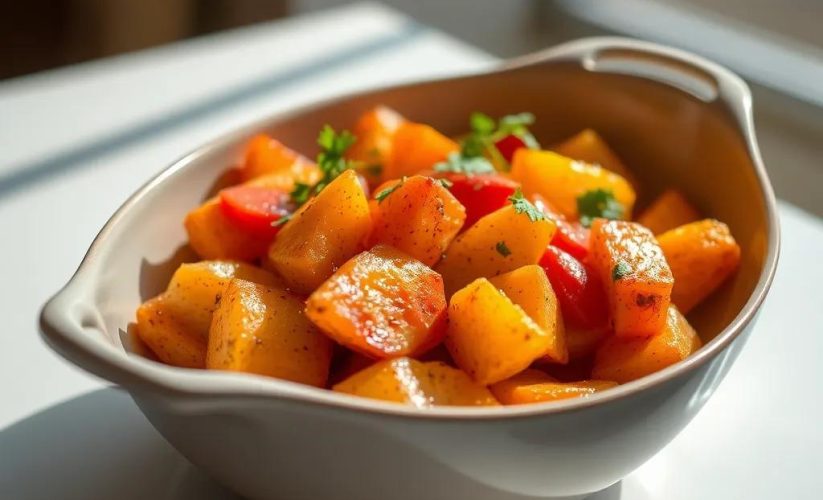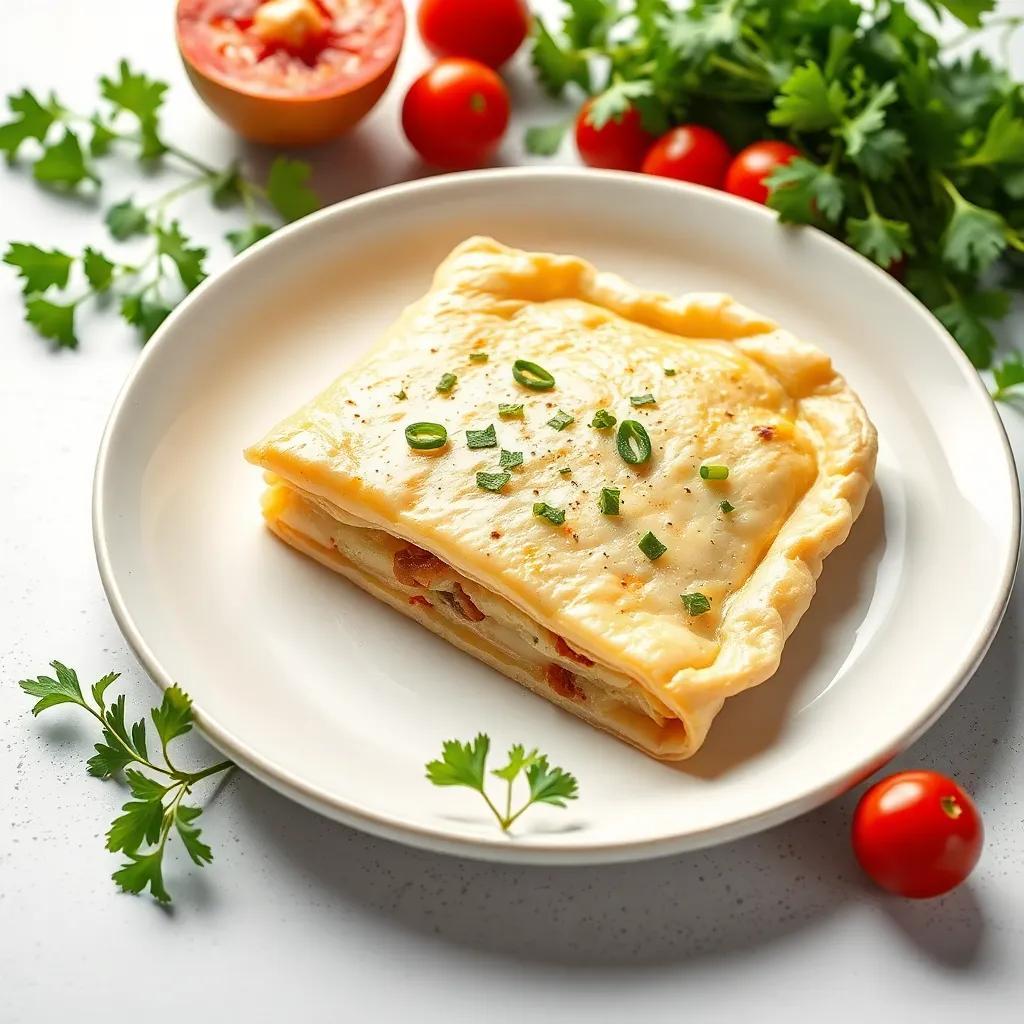Souvlaki Secrets Revealed: Easy, Flavor-Packed Greek Skewers Recipe

Souvlaki Secrets Revealed: Easy, Flavor-Packed Greek Skewers Recipe
🌍 Cuisine: Greek
⚙️ Difficulty: Easy
Ingredients
Nutrition Facts
350 kcal
Instructions
- Soak wooden skewers in water for at least 30 minutes to prevent burning (skip if using metal skewers).
- In a large bowl, combine the olive oil, lemon juice, minced garlic, dried oregano, ground cumin, salt, and black pepper. Whisk until well mixed.
- Add the cubed pork or chicken to the marinade bowl and toss well to coat all pieces.
- Cover and refrigerate for at least 1 hour, preferably 2-3 hours, to let flavors infuse.
- Preheat your grill, grill pan, or broiler on medium-high heat.
- Thread the marinated meat cubes onto the soaked skewers, leaving a small gap between each piece for even cooking.
- Place the skewers on the grill and cook for about 4-5 minutes per side, turning occasionally until the meat is fully cooked and slightly charred.
- Remove from heat and let skewers rest for 2-3 minutes.
- Serve hot with warm Greek pita bread, tzatziki sauce, and lemon wedges for squeezing over the top.
Serving Suggestions
- Serve with a fresh Greek salad of tomatoes, cucumbers, olives, and feta cheese.
- Accompany with tzatziki sauce or garlic yogurt dip for extra creaminess.
- Wrap the skewers in warm pita bread with sliced onions and peppers for a delicious souvlaki sandwich.
- Offer grilled vegetables, such as zucchini and bell peppers, as side dishes.
- Pair with a chilled glass of white wine or ouzo for a traditional Greek experience.
- Add a sprinkle of fresh chopped parsley or oregano on top for garnish and extra flavor.
- Serve alongside lemon roasted potatoes for a hearty meal.
Table of Contents

Intro
Souvlaki is more than just a delicious meal—it’s a vibrant invitation to experience the heart of Greek culinary tradition right in your own kitchen. This recipe unlocks the secrets behind those irresistible, flavor-packed skewers that are beloved throughout Greece and celebrated worldwide. What makes it truly special is its perfect balance of bold, fresh flavors combined with an incredibly simple preparation process, making it ideal for busy weeknights or casual weekend gatherings.
Whether you’re lighting up the grill for a summer barbecue, hosting a Mediterranean-inspired dinner party, or simply craving a quick yet satisfying main dish, these skewers never fail to impress. They bring a wonderful sense of conviviality to the table, encouraging sharing and dipping into tzatziki, wrapping bites in soft pita, or simply enjoying straight off the skewer.
The magic lies in how effortlessly this recipe transforms everyday ingredients into something remarkably vibrant and authentic. Beyond just food, making souvlaki is a delightful experience—one that invites you to immerse yourself in a timeless cooking ritual that’s as communal as it is tasty. So get ready to savor juicy, aromatic morsels infused with Mediterranean sunshine and create memorable meals that transport you to the sun-drenched streets of Greece.
Ingredient Notes
When it comes to crafting truly authentic and flavorful souvlaki, a few key ingredients play starring roles, elevating this simple street food into a memorable meal. Understanding their characteristics and how to select or substitute them can make all the difference.
Olive Oil:
Extra virgin olive oil is the soul of Greek cooking, and here it acts as both a marinade base and a flavor carrier. Its fruity, slightly peppery notes enhance the meat’s juiciness while adding a subtle richness. When shopping, look for cold-pressed, high-quality olive oil with a robust aroma. If unavailable, a good-quality light olive oil can work, but avoid vegetable oils which lack that signature Mediterranean flavor.
Dried Oregano:
Dried oregano is arguably the herb most synonymous with Greek cuisine. Its pungent, slightly bitter, and aromatic flavor infuses the marinade with a rustic earthiness that pairs beautifully with garlic and lemon. Choose Mediterranean oregano when possible, as herbs labeled simply “oregano” in other markets might be milder or grassy. If you can’t find dried oregano, substitute with fresh oregano (use about three times the amount) or a blend of thyme and marjoram for a similar herbaceous punch.
Fresh Lemon Juice:
Freshly squeezed lemon juice brightens the marinade, adding a tangy, citrusy lift that balances the richness of the meat and olive oil. Bottled lemon juice lacks the fresh vibrancy crucial to this dish, so always opt for fresh lemons. Besides flavor, the acidity also helps tenderize the meat, ensuring each skewer is juicy and tender.
Garlic:
Raw garlic brings pungency and a sharp, savory depth to the marinade. Freshly minced garlic releases the essential oils that soak into the meat during marination, creating subtle warmth without overpowering. For those seeking a gentler garlic flavor, roasting the garlic beforehand or using garlic powder sparingly can provide a milder alternative without losing its aromatic charm.
Together, these ingredients form the classic backbone of souvlaki’s flavor—simple, approachable, and irresistibly Greek. Selecting them thoughtfully unlocks layers of taste that turn a straightforward skewer into a celebration of Mediterranean tradition.
Tips & Variations
Mastering souvlaki is all about layering flavor and adapting the recipe to fit your kitchen style and dietary needs. Here are some pro tips and fun twists to elevate your Greek skewers beyond basic expectations:
- Marinade Magic: While the classic lemon-oregano-garlic combo is fantastic, try adding a splash of red wine vinegar or a teaspoon of smoked paprika to deepen the flavor profile. For an even more tender bite, marinate overnight—this allows the meat fibers to soak up the marinade for a juicier, more aromatic result.
- Meat Choices & Swaps: Traditionally, pork shoulder or chicken breast shine here, but feel free to experiment. Lamb cubes bring an authentic Aegean flair with a richer taste, while beef sirloin offers a hearty alternative. For a quick weeknight shortcut, thinly sliced chicken thighs work beautifully and cook faster. To keep it lean, turkey breast can be used, too.
- Going Plant-Based: Vegetarian or vegan friends won’t miss a beat—swap the meat for thick, firm cubes of tofu, tempeh, or large chunks of marinated mushrooms like portobello or king oyster. Use the same marinade for that irresistible Greek tang. Grill until nicely charred and juicy, then serve with vegan tzatziki made from coconut or soy yogurt.
- Spice It Up or Tone It Down: Customize the spice level by adding a pinch of cayenne or chili flakes for gentle heat, or omit the cumin for a more subtle earthy flavor. Fresh herbs like mint or dill can be woven into the marinade to brighten the taste and add complexity.
- Skewer Savvy: If using wooden skewers, always soak them to prevent burning and snapping on the grill. For a more authentic presentation, consider flat metal skewers—they provide even heat distribution and extra sturdiness.
- Serving Style Variations: Skip the pita and layer cooked souvlaki cubes over a vibrant Greek salad for a grain-free option. Alternatively, chop the grilled meat and fold it into wraps or bowls with couscous, olives, and roasted veggies for a Mediterranean-inspired feast.
- Gluten-Free Friendly: This recipe is naturally gluten-free when served without pita. Just double-check condiments like tzatziki or store-bought sauces to ensure no hidden gluten sneaks in.
- One-Pan Oven Roasting: Don’t have a grill? No problem. Arrange skewers on a baking sheet lined with foil or parchment, and roast under the broiler, turning halfway through for an easy stovetop or oven method that still delivers that prized charred flavor.
With a few simple adaptations, this souvlaki recipe transforms seamlessly from a casual backyard favorite to a versatile dish that suits all tastes and lifestyles. Embrace these tips to discover your perfect Greek skewer experience every time.
Leftovers & Storage
After enjoying your delicious souvlaki skewers, you might find yourself with some leftovers to savor later—or you may want to meal prep for a quick, flavorful lunch. Proper storage is key to preserving the tender juiciness and vibrant Mediterranean flavors that make this dish so special.
Refrigeration:
Place leftover grilled meat cubes on the skewers or remove them, depending on your preference, and transfer into an airtight container. Glass containers with tight-fitting lids work wonders to maintain freshness while preventing any aromas from mingling with other foods in the fridge. Stored this way, souvlaki will keep well for up to 3 to 4 days. Be sure to cool the meat to room temperature before refrigerating to avoid condensation, which can affect texture.
Freezing:
For longer storage, freeze your souvlaki skewers or simply the meat cubes separately. Wrap each skewer tightly in plastic wrap or aluminum foil, then place them in a freezer-safe ziplock bag or container. Meat cubes alone can be portioned into bags with marinade included to lock in flavor. Frozen souvlaki maintains best quality for up to 2 months. When ready to enjoy, thaw overnight in the refrigerator and reheat gently on the grill, stovetop pan, or oven to regain that beautiful char and warmth.
Reheating Tips:
To retain moisture and prevent drying out, reheat souvlaki slowly. Cover the skewers or meat with foil and warm in a 325°F (160°C) oven for about 10–15 minutes, or heat gently on a grill pan over medium heat, turning occasionally. Avoid microwaving directly, as it can toughen the meat and dilute flavors.
Meal Prep & On-the-Go:
Souvlaki is an excellent candidate for meal prep thanks to its easy portioning and reheating. Pack individual servings in sealed containers with separate compartments for pita, tzatziki sauce, and lemon wedges to keep everything fresh and vibrant. This makes for an effortless grab-and-go lunch that transports the joyous spirit of a Greek street food feast wherever you are.
By following these storage and reheating tips, you’ll ensure every bite of your souvlaki remains as appetizing as the first time you grilled it—ready to delight your taste buds anytime.
Behind the Recipe
Souvlaki carries with it the soul of Greek culinary heritage, rooted deeply in the vibrant street food culture that has thrived around bustling marketplaces and seaside tavernas for centuries. The word “souvlaki” itself means “small skewer” in Greek, a humble name for a dish that has become an iconic symbol of Mediterranean hospitality and communal dining. Traditionally, it was a no-fuss meal for farmers and fishermen, who needed something quick, portable, and packed with flavor after long days under the Aegean sun.
This recipe draws inspiration from those simple origins, embracing the age-old techniques and ingredients that have been passed down through generations. The marriage of olive oil, lemon, garlic, and oregano creates a marinade that would feel right at home in a seaside village, where every meal bursts with freshness and heartiness. Beyond its Mediterranean roots, souvlaki represents something special—a ritual of sharing, grilling, and gathering that transcends borders and brings people together.
For many, this dish sparks personal memories of summer holidays, family celebrations, and lively street festivals in Greece. The sizzle of marinated meat on the grill, the whistle of lemon juice squeezed over the top, and the warmth of soft pita wrapped around each bite all evoke moments of joy and connection. Preparing souvlaki at home allows you to tap into that same timeless experience—whether you’re recreating a vacation favorite or crafting new traditions with loved ones.
In essence, this recipe isn’t just about cooking skewers; it’s an invitation to savor a slice of Greek culture, offering a delicious gateway into the simplicity, warmth, and communal spirit that make souvlaki a beloved classic worldwide.
FAQ
Can I use a different type of meat instead of pork or chicken?
What’s a good vegetarian alternative for souvlaki skewers?
How far in advance can I marinate the meat?
Is it okay to freeze souvlaki once it’s cooked?
Any tips for making the skewers extra flavorful and juicy?
Can I prepare souvlaki indoors without a grill?
Final Thoughts
There’s something truly special about savoring a perfectly grilled skewer bursting with vibrant, authentic flavors—and this easy souvlaki recipe captures that magic in every bite. Whether you’re new to Greek cuisine or a longtime fan, these juicy, flavor-packed skewers are sure to bring a taste of the Mediterranean right into your kitchen.
Give the recipe a try and make it your own—you might discover your new favorite weeknight meal! Don’t forget to share how it turned out, drop a comment, or rate the recipe below. We’d love to hear about your unique twists and stories from the grill!












